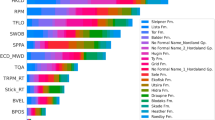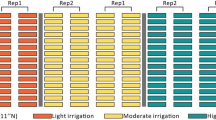Abstract
Least squares support vector machines (LS-SVMs), a nonlinear kemel based machine was introduced to investigate the prospects of application of this approach in modelling water vapor and carbon dioxide fluxes above a summer maize field using the dataset obtained in the North China Plain with eddy covariance technique. The performances of the LS-SVMs were compared to the corresponding models obtained with radial basis function (RBF) neural networks. The results indicated the trained LS-SVMs with a radial basis function kernel had satisfactory performance in modelling surface fluxes; its excellent approximation and generalization property shed new light on the study on complex processes in ecosystem.
Similar content being viewed by others
References
Anthoni, P.M., Freibauer, A., Kolle, O., Schulze, E.D., 2004. Winter wheat carbon exchange in Thuringia, Germany.Agricultural and Forest Meteorology,121:55–67.
Arora, V.K., 2003. Simulating energy and carbon fluxes over winter wheat using coupled land surface and terrestrial ecosystem models.Agricultural and Forest Meteorology,118:21–47.
Baldocchi, D.D., Wilson, K.B., 2001. Modelling CO2 and water vapor exchange of a temperate broadleaved forest across hourly to decadal time scales.Ecological Modelling,142:155–184.
Bosveld, F.C., Bouten, W., 2001. Evaluation of transpiration models with observations over a Douglas-fir forest.Agricultural and Forest Meteorology,108:247–264.
Demuth, H., Beale, M., 1994. Neural Network Toolbox for Use with MATLAB, Natick, The Math Works, Inc.
Duan, K., Keerthi, S., Poo, A., 2001. Evaluation of Simple Performance Measures for Tuning SVM Hyperparameters (Tech. Rep. No. Control Division Technical Report CD-01-11). Department of Mechanical Engineering, National University of Singapore.
Falge, E., Baldocchi, D., Olson, R., Anthoni, P., Aubinet, M., Bernhofer, C., Burba, G., Ceulemans, R., Clement, R., Dolman, H.,et al., 2001. Gap filling strategies for defensible annual sums of net ecosystem exchange.Agricultural and Forest Meteorology,107:43–69.
Flerchinger, G.N., Pierson, F.B., 1991. Modelling plant canopy effects on variability of soil temperature and water.Agric. and Forest Meteor,56:227–246.
Flerchinger, G.N., Hanson, C.L., Wight, J.R., 1996. Modelling of evapotranspiration and surface energy budgets across a watershed.Water Resour. Res.,32(8):2539–2548.
Franks, S.W., Beven, K., 1999. Conditioning a multiple patch SVAT model using uncertain time-space estimates of latent heat fluxes as inferred from remotely sensed data.Water Resour. Res.,35:2751–2761.
Franks, S.W., Beven, K.J., Quinn, P.F., Wright, I.R., 1997. On the sensitivity of soil-vegetation-atmosphere transfer (SVAT) schemes: Equifinality and the problem of robust calibration.Agric. Forest Meteor,86:63–75.
Granier, A., Ceschia, E., Damesin, C., Dufrêne, E., Epron, D., Gross, P., Lebaube, S., Le Dantec, V., Le Goff, N., Lemoine, D.,et al. 2000a. The carbon balance of a young beech forest.Funct. Ecol.,14:312–325.
Granier, A., Biron, P., Lemoine, D., 2000b. Water balance, transpiration and canopy conductance in two beech stands.Agric. Forest Meteor.,100:291–308.
Huntingford, C., Cox, P.M., 1997. Use of statistical and neural network techniques to detect how stomatal conductance responds to changes in the local environment.Ecol. Model.,97:217–246.
Jemwa, G.T., Aldrich, C., 2003. Identification of Chaotic Process Systems with Least Squares Support Vector Machines. Neural Networks. Proceedings of the International Joint Conference on Volume 3, p. 20–24.
Kelliher, F.M., Hollinger, D.Y., Schulze, E.D., Vygodskaya, N.N., Byers, J.N., Hunt, J.E., McSeveny, T.M., Milukova, L., Sogachev, A.F., Varlagin, A.V.,et al., 1997. Evaporation from an eastern Siberian larch forest.Agric. Forest Meteor.,85:135–147.
Kosko, B., 1992. Neural Networks and Fuzzy System. A Dynamical Systems Approach to Machine Intelligence. New Jersey, Prentice-Hall, Inc, Englewood Cliffs., p. 449.
Mo, X.G., Beven, K., 2004. Multi-objective parameter conditioning of a three-source wheat canopy model.Agricultural and Forest Meteorology,122:39–63.
Pelckmans, K., Suykens, J.A.K., Van Gestel T., De Brabanter, J., Lukas, L., Hamers, B., Moor, B., Vandewalle, J., 2002. A Matlab/C Toolbox for Least Squares Support Vector Machines. Internal Report 02-44. ESAT-SISTA and K.U. Leuven, Belgium.
Schulz, H., Härtling, S., 2003. Vitality analysis of Scots pines using a multivariate approach.Forest Ecology and Management,186:73–846.
Suykens, J.A.K., 2001. Nonlinear Modelling and Support Vector Machines. Budapest, Hungary. IEEE Instruments and Measurement Technology Conference.
Thissen, U., van Brakel, R., de Weijer, A.P., Melssen, W.J., Buydens, L.M.C., 2003. Using support vector machines for time series prediction.Chemometrics and Intelligent Laboratory Systems,69:35–49.
Unland, H.E., Houser, P.R., Shuttleworth, W.J., Yang, Z.L., 1996. Surface flux measurement and modelling at a semi-arid Sonoran Desert site.Agricultural and Forest Meteorology,82:119–153.
Valentini, R., Deangelis, P., Matteucci, G., Monaco, R., Dore, S., Mugnozza, G.E.S., 1996. Seasonal net carbon dioxide exchange of a beech forest with the atmosphere.Global Change Biol.,2:199–208.
van Wijk, M.T., Bouten, W., 1999. Water and carbon fluxes above European coniferous forests modeled with artificial neural networks.Ecological Modelling,20:181–197.
Vapnik, V., 1995. The Nature of Statistical Learning Theory. Springer-Verlag, New York, p. 311.
Vapnik, V., 1998. Statistical Learning Theory. John Wiley and Sons, New York.
Vapnik, V., 1999. The Nature of Statistical Learning Theory. 2nd Ed., Springer-Verlag, New York.
Witten, I. H., Frank, E., 2000. Data Mining: Practical Machine Learning Tools and Techniques with Java Implementations. San Diego, CA: Morgan Kaufmann.
Author information
Authors and Affiliations
Corresponding author
Additional information
Project supported by the National Science Fund for Outstanding Youth Overseas (No. 40328001) and the Key Research Plan of the Knowledge Innovation Project of the Institute of Geographic Sciences and Natural Reseources, Chinese Academy of Sciences (No. KZCXI-SW-01)
Rights and permissions
About this article
Cite this article
Qin, Z., Yu, Q., Li, J. et al. Application of least squares vector machines in modelling water vapor and carbon dioxide fluxes over a cropland. J Zheijang Univ Sci B 6, 491–495 (2005). https://doi.org/10.1631/jzus.2005.B0491
Received:
Accepted:
Published:
Issue Date:
DOI: https://doi.org/10.1631/jzus.2005.B0491
Key words
- Least squares support vector machines (LS-SVMs)
- Water vapor and carbon dioxide fluxes exchange
- Radial basis function (RBF) neural networks




